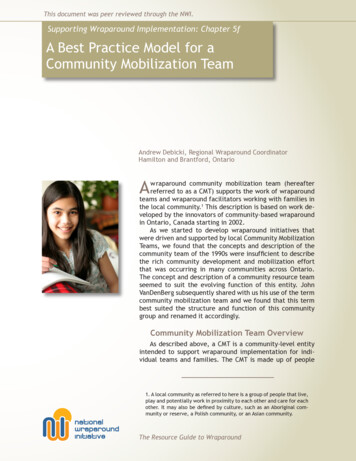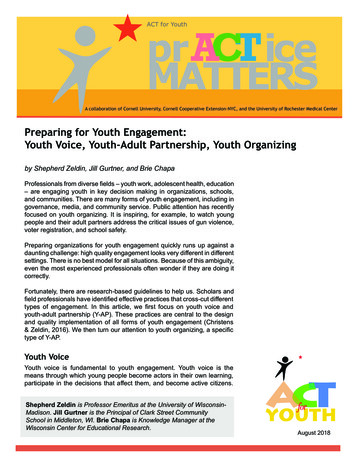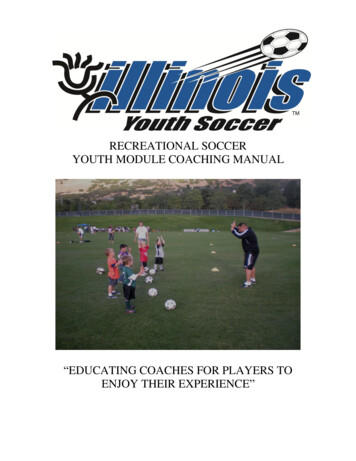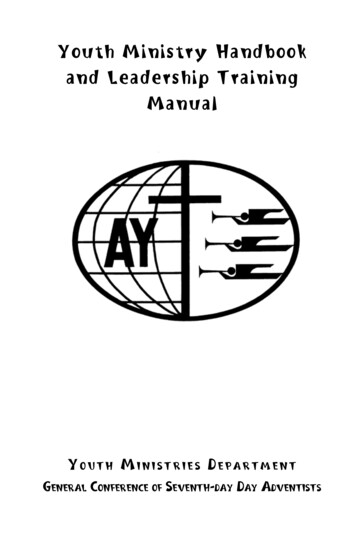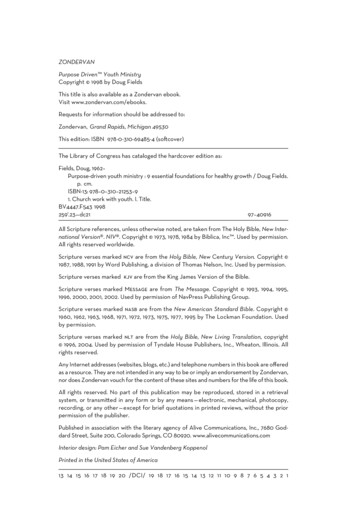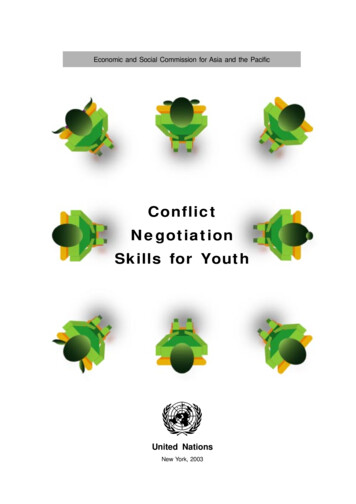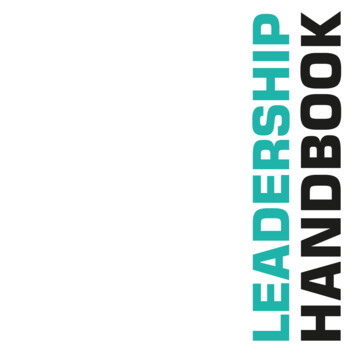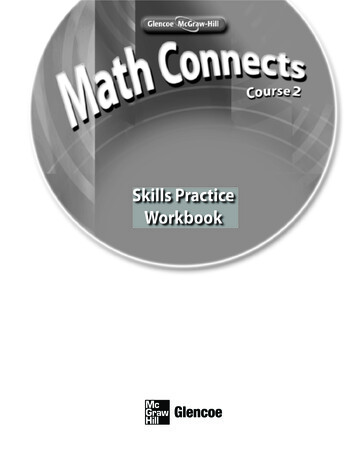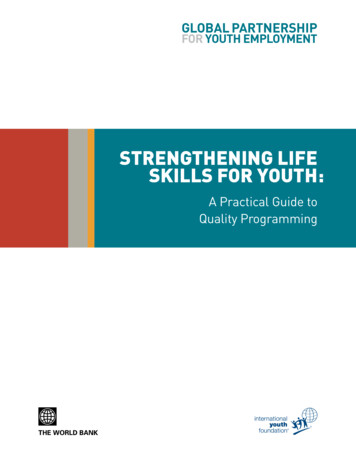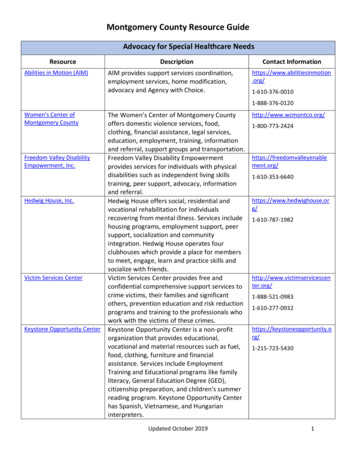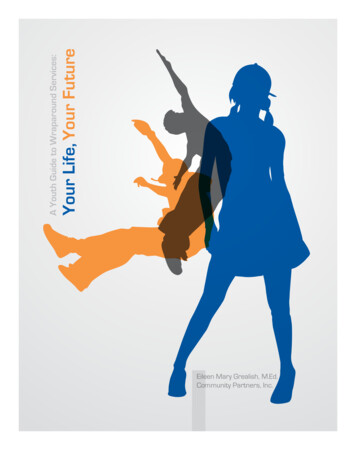
Transcription
Eileen Mary Grealish, M.Ed.Community Partners, Inc.Your Life, Your FutureA Youth Guide to Wraparound Services:
Table of Contents2Acknowledgements3Wrap-a-what?4Why Wraparound?6Do I Have a Choice?7So, What Can I Choose?8What If.?10Exactly How Does This Work?23Closing24Wraparound Checklist25ReferencesA Youth Guide to Wraparound Services: Your Life,Your Future1
AcknowledgementsI want to thank the following people for their invaluable feedback on thisguidebook: Alice Preble, Annie Unpingco, Barbara Burns, Bill Jolly, BJ Cloud,Brad Norman, Bruce Kamradt, Carroll Lytch, Cheri Hartman, Chris Fox, ChuckHalligan, Connie Schnoes, Craig Bass, Darrell Evora, Dave Jolly, David Hafter,David Osher, Debbie Yip, Deloris Hamilton-Butler, Don Burge, members of theEastfield Ming Quong Youth Council, Eric Bruns, Gary Blau, George Montgomery,Gerry Rodriguez, Heidi Nelson, Ira Burnim, Ira Lourie, Janet Walker, Jill Weise,John Franz, John Pierce, Karl Dennis, Kathleen Finnerty, Kathryn Szewczuk, KathyDennis, Kelly Crowley, Kim Todd, Lee LeGrice, Libby Cable, Lisa Benton, LorettaChavez, Lyn Farr, Martha Kaufman, Mary Jo Meyers, Maryann Williams, MaureenMcGlone, Melanie Swift, Michele Herman, Mike Epstein, Mona Gauthier, NarellJoyner, Pam Davis, Pat Miles, Paul Vincent, Rebecca Livingston, Rena Brown,Robert Milford, Ron Taglienti, Sandy Ayres, Sue Smith, Susan Davis, SusanneLuebke, Ted Blevins, Trina Osher, Vera Pina, and Vicki Warren.Development of this guidebook was partially supported by the Child, Adolescentand Family Branch, Center for Mental Health Services, Substance Abuse andMental Health Services Administration. I am grateful to the Branch, under GaryBlau’s able leadership, for making this publication possible. Thanks also toMartha Pien, DB Consulting Group, Inc., for her editorial expertise andassistance in the development of this guidebook. And, finally, a special thankyou to my two favorite teachers—Jessica Grealish Smith and Joshua Thomas(J.T.) Smith.The content of this publication does not necessarily reflect the views, opinions, orpolicies of the Center for Mental Health Services, the Substance Abuse and MentalHealth Services Administration, or the U.S. Department of Health and HumanServices.2A Youth Guide to Wraparound Services: Your Life,Your Future
Wrap-a-what?Someone cares about your life and future. That’s why you’ve been recommended forWraparound. Funny name for a process that has one goal: supporting you in makingpositive life choices.Wraparound provides this support through a team created for you and by you. Someteam members will be people who provide you and your family support services, such ascounselors and therapists. Others will be people you choose because you care about oneanother—for example, family members, a good friend, or a favorite teacher.Team members support you as you figure out what’s working in your life and what isn’t.Together, you and your team create a plan of action based on your challenges, yourdreams, and your life. Your Wraparound plan is unique to you and your situation.While no two Wraparound plans look alike, teens in Wraparound seem to want the samething: to feel loved and safe in their families, friendships, and communities. They want tofind ways to express themselves to others. Wraparound can help with all that.A Youth Guide to Wraparound Services: Your Life,Your Future3
Why Wraparound?Many young people choose Wraparound because they want something in their lives to get better.Maybe it’s their family lives, friendships, or grades. Perhaps it’s their feelings about themselves andothers. Often, it’s many things.Some young people don’t choose Wraparound. It is chosen for them, maybe by a family member,a therapist, or even a judge. They may have had problems with the law, drugs or alcohol, and lotsof other stuff—food, sex, cutting, skipping school, running away, and more.However young people come to Wraparound, they all face challenges. Some have been labeleddepressed. Others have been told they have anxiety disorder, bipolar disorder, oppositionaldefiant disorder, or attention deficit hyperactivity disorder. Some teens take medication to help,while others find medication isn’t effective. Wraparound pulls together services that help teenstackle challenges with their feelings and behavior.Sometimes young people come to Wraparound because of a medical problem or a disability. Theyhave to deal with breathing machines or communicate by using computers. They need lots ofhigh-tech support to be independent or just to stay alive. Wraparound helps them get what theyneed, get it working, and keep it up to date.Other times, parents’ problems with alcohol or drug use, mental illness, physical disability, ordangerous or criminal behavior have created serious challenges for their children. Some parentsmay hurt their children, and some children may hurt their parents.Wraparound can help keep you safe and help your parents, too. Of course, not all young peoplehave parents to care for them. If you are in this situation, Wraparound will work with you to findother family members or adults who can serve this important role. 1Whether you have chosen Wraparound or it was chosen for you, you’ll soon be part of a team. Yourteam will support you as you think about what you like and don’t like in your life and what youwant to be better. Your team will give you the support and skills you need to make good thingshappen.4A Youth Guide to Wraparound Services: Your Life,Your Future
Wrap Your Head Around This .Wraparound equals success when teenscommit to the process. For example, teens inWraparound: Improve school attendance and grades Have fewer discipline issues at school Are less likely to engage in risky behavior Live in less restrictive environments 2, 3A Youth Guide to Wraparound Services: Your Life,Your Future5
Do I Have a Choice?6Counties across the nationdecide who they think needsWraparound. If you’re readingthis, you live in a county thatbelieves Wraparound wouldbenefit you. Maybe you’vebeen asked to considerWraparound as well asother support programs,all of which sound prettygood to you.Chances are, though,you may be facedwith a “forced choice.”This means that you andyour parents are requiredto pick between Wraparound and one or two other options, like lock up orplacement in a residential treatment center. Those options would meanliving away from home for a while.And sometimes, Wraparound is not a choice but a legal requirement.Because something risky or illegal has happened in your life or within yourfamily, a legal authority requires you to participate in Wraparound.A Youth Guide to Wraparound Services: Your Life,Your Future
So, What Can I Choose?There’s no getting around the age thing: if you are under 18, adults have legal responsibilityfor your decisions. That said, the point of Wraparound is to involve you as much as possiblein choices that affect your life. For example, in Wraparound you will: Help pick and guide your support team. Create your plan with input from all team members—not just the therapists, doctors,teachers, and other professionals. Include activities and interests in your plan that you like—sports, music, you name it. If youwant to strengthen a relationship with someone in your family, your Wraparound team willhelp you do that.If you have done something illegal or unsafe for you or others, you will have fewer choices inWraparound. As your actions become safer, you will likely get more choices and make moredecisions for yourself.A Youth Guide to Wraparound Services: Your Life,Your Future7
What If . I’ve Heard It All Before?You have probably heard about other “youth programs” and maybe even have beenin one or two. While some people call Wraparound a program, it’s really a process.That process begins with you—by identifying your strengths and challenges—andends with you—by making positive choices to improve your life. During this process,a team you’ve helped build works with you to be sure you have a plan that gets youwhere you want to be in life.Once you’re in Wraparound, you can expect to: Be part of a team that includes family or other caregivers and others whosupport you and your goals. Be listened to and treated with respect. Be able to tell your story, your way, without being judged. Be held responsible for what you do or say you’ll do. Hold others responsible for what they do or say they’ll do. I’m Angry?Many young people come to Wraparound angry. Some ofthem are in trouble at home, at school, and with the law.They have run out of choices. Other young peoplehave made mistakes, some serious, so otherpeople are deciding what will happen tothem. Some just want everybody toleave them alone, but no one will.They are tired of people telling themwhat to do and who to be.Some teens are mad at certain people intheir lives. They are disappointed and feelpeople important to them have let them down.Some have deep hurts they have trouble living with. Forthem, life has been tough.It’s okay to be mad about this stuff. Nobody wants to be let down,and nobody likes to be forced to do things. Over time, though,anger can get in the way of moving forward.Whether you have come to Wraparound by your own choice orbecause you had to, you have been given a chance to honestlylook at yourself, your life, and those in it. The people who reallycare about you will likely be on your team, and that’s a goodstarting point for moving past anger.8A Youth Guide to Wraparound Services: Your Life,Your Future
. I’m Ordered To Do Wraparound?If you are required to be in Wraparound, you need to know this: Something hashappened that got the legal authorities involved with you and your family. That almostalways means you will lose some choices. This is hard on both teens and adults.Legal authorities are required to step in when illegal behavior has happened. They havethe right to decide what those who broke the law have to do to make things right. If youdid something illegal, part of their decision will be based on your track record—forexample, how you’re doing in school and whether you’ve been involved with the lawbefore.If a member of your family broke the law, the same applies to them. Is it the first time orthe fifth? Is your relative working? Taking care of you and other children responsibly? Allthese factors and more will matter a lot when determining what happens next.A lot of young people think it isn’t fair that what happens to them depends on otherpeople in their families, especially their parents and other adult caregivers. However, ina difficult situation like this, Wraparound can help get your family back on track.IF YOU’VE BEEN ORDERED INTO WRAPAROUND. here’s how tomake the most of it. How you act makes a difference in how people treat you. Treat people with respectand good manners and they will often do the same for you. Cooperate with Wraparound planning. If you are having trouble, talk to someone onyour Wraparound team so you can get help. If you have messed up, apologize and ask how you can make up for it. If somebodyelse messed up, try to forgive the person. Give him or her a chance to change. Do some good to make up for anything you did wrong. If you didn’t do anythingwrong, do something good just to do it! If you need help with this, talk with yourteam. Ask your team to tell you what you have to do so you can earn more choices. Ask your team what you should not do and how they can help you not do it. If you feel anyone on the Wraparound team is being disrespectful of you or yourfamily, politely speak up or ask someone you trust to speak up for you. Do this whenanything is bothering you.Because Wraparound is unique to you—and your family—it can be very effective. Itgathers on one team all the people who can help you tackle your challenges and builda positive future. Most important, your voice and choice matter in Wraparound.A Youth Guide to Wraparound Services: Your Life,Your Future9
Exactly How Does This Work?Let’s talk about what Wraparound really means for you.As a start, read through the steps that follow before you meet with yourWraparound facilitator. Jot down your thoughts as you’re reading. Thisguidebook is your map for where you want your life to go, so feel free tomake notes on how you want to get there.Meeting With YourWraparound Facilitator1.5 Hours for Steps 1-3Step 1: Getting to Know YouIn Step 1 of Wraparound, a facilitator visits you at home—or whereveryou’re most comfortable—to get to know you. The facilitator alsomeets your parents or guardian in this visit. Sometimes one ortwo other Wraparound people also attend this first visit (seeWho Might I Meet in Wraparound?).The facilitator tells you more about Wraparound andanswers your questions. Of course, if you have ques tions any time during the Wraparound process, pleaseask them. Wraparound is about you, and your voicewill always be heard.During this visit, the facilitator wants to learn about yourstrengths—what’s important to you, what you like to do, andwhat you want your life to be like now and in the future. Yourstrengths also can include your faith, what inspires you, andyour favorite people. And mention any hobbies, specialtalents, and music you like—these are also strengths.So, share your strengths, even brag a bit. The more yourfacilitator learns about you, the more effective Wraparound willbe for you.10A Youth Guide to Wraparound Services: Your Life,Your Future
My facilitator’s name is:Our meeting is scheduled for:DateTimePlaceMy strengths include.Favorite ActivitiesSpecial InterestsBeliefs / FaithHopes / DreamsFavorite / MostHelpful PeopleOther StrengthsFacilitatorsTo facilitate is to coordinate and help meetings andplans go smoothly. Facilitators do the following: Assess your strengths, goals, and needs Help you develop an initial safety and crisis plan Help you build your Wraparound team Help you create your Wraparound plan Manage meetings Participate in your plan Follow up on your plan Ensure key documents are where they should be Get plans and funding approvedSometimes the facilitator just runs the meetings andother staff do the rest. Other times, facilitators workwith you to support every aspect of your Wraparoundexperience. Facilitators usually are college graduates,and many have advanced degrees.A Youth Guide to Wraparound Services: Your Life,Your Future11
You can invite family members or other people important to your life to join this first meeting with yourfacilitator. As long as there’s no official paperwork saying you can’t see a certain person, you are welcometo include anyone who matters to you.During this meeting, the facilitator also wants to learn which areas of your life you want or are required towork on while in Wraparound. Often, teens set goals in the following areas, called life ce to LiveWorkSocialHealthEmotionalSpiritualBefore, during, and after your first meeting, the words in this list can guide you as you think of areas of yourlife you want or need to be better. To help you get started, check any of the domains that apply to you.Do you feel bored or lonely? Try new activities and meet new people by targeting goals in the socialdomain. Want to pass all your classes? Then focus on the education domain. Maybe your biggest challengeis to get off probation. If so, choose goals in the legal domain.By meeting your goals you will create positive outcomes. For example, getting grades of C or above wouldbe an outcome of achieving your goal to pass all classes, which falls in the education domain.Usually, teens in Wraparound want things to improve in several life domains. Perhaps they want somethingto be different in their family, in how they feel about things, and in how they act. Setting goals in the family,emotional, spiritual, and behavior domains could all be good choices in this situation.Now picture what your life will look like when things improve in each area you’ve checked. As a solid nextstep, make your list of what you need to get to this better life you’re working on in Wraparound. Items onyour list might fall into such categories as: Emotional support—like having love and understanding Behavioral support—such as having a mentor to learn good communication skills Logistical support—perhaps having a ride to appointments Service support—such as having a counselor or tutorDare to dream and ask for what you need—it’s your life. In the Life Domains Activity chart, write down eachlife area you checked above. Next, jot down what good things (outcomes) might come from improving thatarea. Then, record what you think might help improve that part of your life.12A Youth Guide to Wraparound Services: Your Life,Your Future
LIFE DOMAINS ACTIVITYLife Domain I WantTo ImproveExample: Family lifeOutcomes If ThisDomain ImprovesWhat I Need For ThisDomain To ImproveExamples: We will have no more than threesmall fights a week.Examples: Peaceful ways to solve arguments I can go out with, visit, or havefriends over at least three to fourtimes a week. Rules my parents and I agree on I will spend one night a week withmy Uncle John. Rides to visit my Uncle JohnNote: If you do this activity when you first review this guidebook, terrific. If not, please complete it beforeyour first Wraparound team meeting.A Youth Guide to Wraparound Services: Your Life,Your Future13
Step 2: Building Your Wraparound TeamIn your first meeting with the facilitator, you also complete Step 2. This step involves figuringout who will be on your Wraparound team.Your team will include some professionals—for example, a teacher, therapist, and probationofficer—as well as family members, friends, and other people you like and trust. Parents,siblings, grandparents, aunts, uncles, neighbors, coaches, people from where youworship—you choose. The point is to build a team with people who make you feelcomfortable and who might be helpful in the Wraparound process.If you or anyone in your family is in trouble, there might be people on the team youand your family do not really want to be there. This happens mostly when somebodyis involved with a court or a judge. If someone at court says a person has to bethere, teens and their families have to accept that.14A Youth Guide to Wraparound Services: Your Life,Your Future
Who Might I Meet in Wraparound?In addition to your facilitator, here are some other people you might meet inWraparound. Their support and skills can make a good Wraparound experienceeven better.Family SpecialistsSome Wraparound programs have staff, often called family specialists, who areavailable to help and keep the process moving efficiently. Family specialists areoften very flexible and always prepared to do whatever the Wraparound planrequires. They can work with you and your family on anything—from helpingmeet your most basic life needs to making friends, getting jobs, and supportingpositive life changes during the Wraparound process.AdvocatesSometimes advocates serve the same role as family specialists. In mostprograms, though, they’re called advocates because they help young peopleand their families get through whatever they’re dealing with—school planningmeetings, court, and decisions about what gets paid for or what services familiesreceive. In other programs, advocates have more general roles. They stick up forpeople who are trying to make important changes in their lives—both teensand their families.Parent Partners/Family LiaisonsWraparound is increasingly enlisting parents, grandparents, and other familymembers of young people who are in or have graduated from Wraparound tosupport families new to Wraparound. What they do varies from program toprogram. For example, parent partners/family liaisons may serve as soundingboards or informal counselors or help in assessment and planning. Typically,parents are their main focus, but they also may focus on teens if that makes theWraparound plan work better.Youth CoordinatorsThe role of youth coordinator is new to Wraparound and has been very wellreceived. What parent partners do for adult family members, youth coordinatorsdo for teens. Many youth coordinators needed or have received services likethose found in Wraparound. Others have participated in plans for their brothers,sisters, or parents. Their personal experience helps them understand how toeffectively reach out to young people. Youth coordinators organize groupactivities and interact with youth one-on-one. They serve as mentors andcoaches. Like parent partners, they are flexible and fill whatever role isneeded on Wraparound teams and in Wraparound plans.EvaluatorsEvaluators don’t participate in Wraparound but instead measure how well theprocess is working. Talking to you and your parents is one of the most importantways to evaluate its effectiveness. Some evaluators are parents, while others arestudents or university professors. Whatever their background, evaluators aretrained to help you express your opinions honestly about things that matter, toobserve Wraparound meetings, and to measure how well your Wraparound planis working. You will usually meet evaluators before you meet Wraparoundpeople and then see them again as the process continues. Evaluators don’trepeat what you tell them unless they think you or others around you aren’t safe.A Youth Guide to Wraparound Services: Your Life,Your Future15
NO TWO WRAPAROUND TEAMS LOOK THE SAMESee what works for some teens. Peter’s team includes his mom, her best friend, his favorite uncle, his probation officer, his choir director, his social worker,and a court counselor. Janni’s team includes her grandparents, the Vice Principal at her school, her therapist, her best friend, and her grandad’s AAsponsor. Juan’s team includes his dad and his dad’s girlfriend, his mom and her boyfriend, his Big Brother, his faith-based youthgroup leader, his homeroom teacher from 2 years ago, a family specialist, and the youth coordinator from the Wraparoundprogram. Leahs’ team includes her foster parents, her dad and little brother, her Girl Scout leader, her best friend from the troop, hersocial worker, her brother’s therapist, and her guardian ad litem. Sams’ team includes staff from the group home he was in, a permanency planning specialist, his psychologist, and his oldersister. Gabriella’s team includes her parents, her sisters, her science teacher, the school librarian, and a Child Protective Servicesworker.16A Youth Guide to Wraparound Services: Your Life,Your Future
OTHERSFRIENDSFA M I LYPeople I want on my Wraparound team include.Step 3: Drafting a Crisis and Safety PlanThe first meeting with your facilitator concludes with Step 3—creating a crisis and safety plan. Your facilitator asks if you oranybody close to you is facing a big change, crisis, or unsafe situation. If these challenges might come up before your firstWraparound team meeting, you need a plan for how to handle them and stay safe.Together, you, your parents or guardian, and your facilitator create this plan. As things get better in your life or as newchallenges arise, you will rework this plan in meetings with your Wraparound team.A Youth Guide to Wraparound Services: Your Life,Your Future17
Meeting With Your Wraparound Team1.5 Hours for Steps 4-6Step 4: Having Your First Team MeetingAbout 2 to 4 weeks later, your Wraparound team meets. The meeting begins with everybody saying who they are and whythey’re there. Next, the facilitator tells the team what he/she learned about your strengths, relationships, and any otherinformation you shared when you met.The facilitator also mentions your family’s strengths and may discuss the rules the team will follow at the meetings—such astreating everyone with respect and not yelling at or interrupting others.A big focus of this first Wraparound team meeting is creating your Wraparound plan—or at least getting a good start on it.Use the list you came up with for the Life Domains Activity on page 13 to begin.With your team, pick the areas from this list you want to or need to work on. Also look at the ideas you jotted down for howto make things better in those domains. Share those ideas with your team mates and be open to their feedback.Together, work on more ideas for how to improve the areas of your life that you and your team agree are important.Someone—you or a team mate—should write down all the ideas the team mentions.Some of the ideas suggested may bepretty general (Example: To feel goodabout myself.) Other ideas might bemore detailed (Example: To feel betterabout myself by attending all sessionswith my social worker and going out forthe track team.)Don’t worry if some ideas are more detailedthan others. The important thing is to thinkof and write down as many ideas as possible.Step 5: Creating YourWraparound PlanAfter all ideas are listed, you and your teamfocus on the details of steps toward improvingareas of your life you want to get better. Try to be asspecific as possible. Think about exactly what needs to change for an area of your life to get better as you do the Activity:Turning Ideas Into Strategies.Once you’ve finished this activity, you’ll have the foundation for a strong plan that will work for you. Then, turn to pages 20-21for a sample plan and space to record your own plan.If you need ideas to help you get started on your plan, check out page 22 to see what’s worked for some teens. Andremember—ask your team mates if you have any questions during this process. This is a team effort, but it’s YOUR plan!18A Youth Guide to Wraparound Services: Your Life,Your Future
ExamplesStrategies for How toMake Change HappenLive with my family, go to my neighborhood school, andhave better relationships with my parents, brothers, andsistersStop hitting people in my family, get no grades worse thana C, and make two friends who aren’t in trouble at school oranywhere elseBe safe at home and make good decisions about how I treatpeopleFor my parent: Stop using drugs and alcoholFor me: Express myself in words when I’m angry and stoprunning away or leaving where I’m supposed to be withoutpermissionFeel as well as possible and stay out of troubleFinish probation successfully by taking my medication,attending school as required, passing random drug tests,doing 200 hours of community service, and not doinganything illegalMy Ideas and StrategiesIdeas for ChangeStrategies for ChangeActivity: Turning Ideas Into StrategiesIdeas for WhatI Want to ChangeA Youth Guide to Wraparound Services: Your Life,Your Future19
My Wraparound Plan20Life Domain I WantTo ImproveOutcomes If ThisDomain Improves[from page 13][from page 13]What I Need for ThisDomain To Improve[from page 13]MyStrengthsStrategiesfor Change[from page 11][from page 19]Who Can Help (AnyTeam Members?)Sample PlanSchool! I flunked a course lastsemester and need to make upthose credits somehow. Thissemester, I’m struggling inEnglish. I will get enough credits tomove to the next grade. I won’t have to do summerschool. I will graduate on time.I need more academic credits. I’m pretty musical. I sing andplay the piano and guitar. Try to get credit for the guitarclass I teach at the after-schoolprogram My Guidance Counselor andMusic teacher I’m good at writing song lyrics. Find out if writing lyrics cancount toward my poetry unit inEnglish My English teacherMy PlanA Youth Guide to Wraparound Services: Your Life,Your FutureA Youth Guide to Wraparound Services: Your Life,Your Future21
Need ideas for your Wraparound plan?Check out these plans. Kelly’s plan lets her call her grandma from school when she feelsanxious and arranged for her to take piano lessons. Carlos’ plan got him a mentor to help him research whatsoldiers promise to do and what they are not allowed todo and then turn what he learns into a personal code ofbehavior. Tammy’s plan got her dad rides to AA meetings, arrangedfor her to volunteer with abandoned animals at theHumane Society, and helped her find and join a religiousstudy group. Darrell’s plan helped him get a website design job, gothim a tutor for the GED, and helped him make restitutionfor what he stole. Peshali’s plan helped her mom get a cosmetology license,got her and her sister into the Boys and Girls Club, andarranged for her to teach dance classes at the communitycenter. George’s plan helped his family find a place to worship, gothim help with his anger, and got him into a communicationskills group. Sari’s plan got her baby brother into preschool, arrangedfor her to sleep over at a relative’s home twice a month,and helped her family get the electricity and cable turnedback on. Russell’s plan got him the right doctor and medicine,found him a lawyer, and helped him change his classschedule at school. Maria’s plan helped her learn about respect bywatching her favorite movies with a counselor,got her a social skills teacher, and helped herlearn to make friends. Anton’s plan got him a guitar and music lessons,found a parenting coach for his parents, and gothim into an after-school program with lots ofmusical activities.22A Youth Guide to Wraparound Services: Your Life,Your FutureRemember—notwo Wraparoundplans are alike. Your planshould fit your life—yourstrengths, your challenges,your needs. It should usestrategies that draw on yourstrengths to meet yourchallenges and needs.Wraparound is about yourvoice and your choice. So, beheard, make choices, getfeedback from your team,and build a plan that worksfor you.
Step 6: Refining Your Crisis and Safety PlanNext, it’s back to crisis and safety planning and figuring out how to handle big changes in your life. Your first crisis and safetyplan was a draft, made when you and the Wraparound staff didn’t yet know each other very well and your team wasn’t inplace.In Step 6—with the support of Wraparound staff who now know you better and team members you have chosen—youadjust
Whether you have come to Wraparound by your own choice or because you had to, you have been given a chance to honestly look at yourself, your life, and those in it. The people who really care about you will likely be on your team, and that’s a good . A Youth Guide to Wraparound Services: Your Life,
